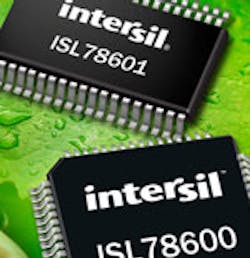Control System Maximises Vehicle Range, Battery Life
AEC-Q100
An automotive-grade (AEC-Q100), lithium-ion battery-management system and safety monitor is the key component of a new hybrid electric-vehicle (HEV)/electric-vehicle (EV) system solution developed by Intersil. The ISL78600 multi-cell solution addresses the safety, reliability, and performance requirements of the EV, HEV, and plug-in hybrid (PHEV) markets.
Though Li-ion batteries help enhance electric and hybrid- electric vehicles, they require specialized semiconductor devices that monitor and manage these cells. The semiconductor monitoring devices must detect battery faults by monitoring each Li-ion cell, with the ability to keep track of the monitoring system itself.
Four important criteria define a reliable Li-ion monitoring system:
• Accuracy: The monitoring system must measure each Li-ion cell’s state to ensure optimal performance of the battery array.
• Comprehensive diagnostics: The system must consistently check its own functionality to make certain each part operates constantly at the required accuracy.
• Communication: The monitoring system must communicate reliably. This is particularly challenging due to the noise associated with battery arrays.
• Safety: Managing the Li-ion cells lets the system avoid failures and safety issues.
In addition to those factors, the semiconductor monitoring devices must constantly check issues such as cell overvoltage and undervoltage, as well as overtemperature. They also have to monitor the system’s power-supply levels, voltage, and temperature. Backup monitoring devices must communicate fault detections among themselves to shut down the entire system, if necessary.
Standard CAN or SPI interfaces provide reliable communications with the microcontroller, but using this type of interface between all monitoring devices drives up expense. Instead, using a CAN interface along with an isolator or using a specialized interface can do the job at minimal added cost, says Intersil.
To address the stringent safety requirements of the automotive market, Intersil's solution complies with ISO26262 (ASIL) to prevent battery-pack failures. There’s also built-in fault detection for all major internal functions, and it detects external faults such as open wire, overvoltage and undervoltage, and temperature and cell-balancing faults.
According to the company, its battery management system has the accuracy needed for state-of-charge measurements to extend vehicle driving range and the life of high-performance Li-Ion batteries. That’s because each ISL78600 device uses a 14-bit, temperature-compensated data converter that scans 12 channels in less than 250 μs.
Average mid-size HEV vehicles today use 126 to 168 cells, which can be addressed with 11 to 14 ISL78600s per vehicle. When combined with four external temperature sensors, the ISL78600 provides accuracy for state-of-charge measurements across the full battery operating temperature range.
To achieve reliability for intra-system communication, the solution uses a high-noise-immunity and transient-tolerant communication scheme. With this fully differential daisy-chain architecture, low-cost twisted-pair wiring can be used to stack multiple battery packs together while protecting against hot plugging and high-voltage transients. Overall, the HEV/EV system solution significantly reduces battery-management system costs, says Intersil.
The ISL78600 connects to microcontrollers via either a 2.5MHz SPI or 400kHz I2C interface, and is specified for -40ºC to 105ºC operation. Although targeted at the HEV/EV market, it can be adapted to address industrial and battery-backup applications.
